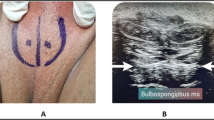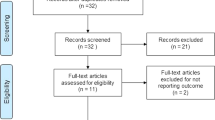Abstract
Botulinum toxin (BTX) is the most potent biological toxin used for the treatment of urologic conditions. During the last 3 years, the use of BTX has been extended to the treatment of symptomatic benign prostatic hyperplasia, however, the actual mechanism through which BTX can reduce prostate volume and infravesical resistance is not well understood. This article reviews the main effects of BTX in prostate tissues. A critical analysis of the outcomes of patients who were studied in clinical series that used this toxin to treat lower urinary tract symptoms related to benign prostatic hyperplasia is also presented.
Key Points
-
By the age of 60 years, half of all men have histologic evidence of benign prostatic hyperplasia (BPH), and virtually all men have BPH by the age of 80 years
-
Botulinum toxin A (BTX-A) is produced by the Gram-positive, anaerobic bacillus Clostridium botulinum, and is regarded as the most potent neurotoxin known to man
-
The effects of BTX-A include inhibition of acetylcholine release at the cholinergic neuromuscular junction and the neuroglandular junction, inhibition of norepinephrine release, and interference with nociception
-
Secretion from and growth of prostate epithelium are under parasympathetic control, so inhibition of parasympathetic neurotransmission with intraprostatic BTX-A injection could be an attractive option for the management of BPH
-
Preliminary studies have shown that intraprostatic injections of BTX-A could be an effective treatment for LUTS due to BPH, with minimal or no side effects; however, most published studies have been small, poorly controlled, and have had limited follow-up
This is a preview of subscription content, access via your institution
Access options
Subscribe to this journal
Receive 12 print issues and online access
$209.00 per year
only $17.42 per issue
Buy this article
- Purchase on Springer Link
- Instant access to full article PDF
Prices may be subject to local taxes which are calculated during checkout
Similar content being viewed by others
References
Berry SJ et al. (1984) The development of human benign prostatic hyperplasia with age. J Urol 132: 474–479
Walsh PC (1996) Treatment of benign prostatic hyperplasia. N Engl J Med 335: 586–587
Wei JT et al. (2005) Urologic diseases in America project: benign prostatic hyperplasia. J Urol 173: 1256–1261
Welch G et al. (2002) Quality-of-life impact of lower urinary tract symptom severity: results from the Health Professionals Follow-up Study. Urology 59: 245–250
AUA Practice Guidelines Committee (2003) AUA guideline on management of benign prostatic hyperplasia. Chapter 1: diagnosis and treatment recommendations. J Urol 170: 530–547
Djavan B et al. (1999) A meta-analysis on the efficacy and tolerability of α1-adrenoceptor antagonists in patients with lower urinary tract symptoms suggestive of benign prostatic obstruction. Eur Urol 36: 1–13
de la Rosette JJ et al. (2002) Long-term risk of re-treatment of patients using alpha-blockers for lower urinary tract symptoms. J Urol 167: 1734–1739
Dmochowski R (2006) Antimuscarinic therapy in men with lower urinary tract symptoms: what is the evidence? Curr Urol Rep 7: 462–467
Blake-James BT et al. (2007) The role of anticholinergics in men with lower urinary tract symptoms suggestive of benign prostatic hyperplasia: a systematic review and meta-analysis. BJU Int 99: 85–96
Rassweiler J et al. (2006) Complications of transurethral resection of the prostate (TURP)—incidence, management, and prevention. Eur Urol 50: 969–980
Mishriki SF et al. (2006) Quality of life after TURP: prospective 12 year follow up [abstract #1427]. J Urol 175 (Suppl): 461
McConnell JD et al. (1994) Benign prostatic hyperplasia: diagnosis and treatment. Agency for Health Care Policy and Research. Clin Pract Guidel Quick Ref Guide Clin 8: 1–17
Thomas CA et al. (2006) Botulinum A toxin for the treatment of benign prostatic hyperplasia/lower urinary tract symptoms. Curr Urol Rep 7: 266–271
Kuo HC (2005) Prostate botulinum A toxin injection—an alternative treatment for benign prostatic obstruction in poor surgical candidates. Urology 65: 670–674
Cruz F and Silva C (2004) Botulinum toxin in the management of lower urinary tract dysfunction: contemporary update. Curr Opin Urol 14: 329–334
Smith CP and Chancellor MB (2004) Emerging role of botulinum toxin in the management of voiding dysfunction. J Urol 171: 2128–2137
Aoki KR and Guyer B (2001) Botulinum toxin type A and other botulinum toxin serotypes: a comparative review of biochemical and pharmacological actions. Eur J Neurol 8 (Suppl 5): 21–29
DasGupta BR (1994) Structures of botulinum neurotoxin, its functional domains, and perspectives on the crystalline type A toxin. In Therapy with Botulinum Toxin, 15–39 (Eds Jankovic J and Hallen M) New York: Marcel Dekker
Scott AB and Suzuki D (1988) Systemic toxicity of botulinum toxin by intramuscular injection in the monkey. Mov Disord 3: 333–335
Smith CP et al. (2003) Effect of botulinum toxin A on the autonomic nervous system of the rat lower urinary tract. J Urol 169: 1896–1900
Argoff CE (2002) A focused review on the use of botulinum toxins for neuropathic pain. Clin J Pain 18 (Suppl): S177–S181
Cui M et al. (2004) Subcutaneous administration of botulinum toxin A reduces formalin-induced pain. Pain 107: 125–133
Grazko MA et al. (1995) Botulinum toxin A for spasticity, muscle spasms, and rigidity. Neurology 45: 712–717
Kuo HC (2003) Effect of botulinum A toxin in the treatment of voiding dysfunction due to detrusor underactivity. Urology 61: 550–554
Reitz A et al. (2004) European experience of 200 cases treated with botulinum-A toxin injections into the detrusor muscle for urinary incontinence due to neurogenic detrusor overactivity. Eur Urol 45: 510–515
Haferkamp A et al. (2004) Lack of ultrastructural detrusor changes following endoscopic injection of botulinum toxin type A in overactive neurogenic bladder. Eur Urol 46: 784–791
Chuang YC and Chancellor MB (2006) The application of botulinum toxin in the prostate. J Urol 176: 2375–2382
Shaari CM et al. (1995) Rhinorrhea is decreased in dogs after nasal application of botulinum toxin. Otolaryngol Head Neck Surg 112: 566–571
Doggweiler R et al. (1998) Botox-induced prostatic involution. Prostate 37: 44–50
Maria G et al. (2003) Relief by botulinum toxin of voiding dysfunction due to benign prostatic hyperplasia: results of a randomized, placebo-controlled study. Urology 62: 259–264
Chuang YC et al. (2005) Botulinum toxin type A improves benign prostatic hyperplasia symptoms in patients with small prostates. Urology 66: 775–779
Chuang YC et al. (2006) Beneficial effects of up to one year with intraprostatic botulinum toxin type A injection on LUTS and quality of life in BPH patients [abstract #1436]. J Urol 175 (Suppl): 464
Ventura S et al. (2002) Cholinergic innervation and function in the prostate gland. Pharmacol Ther 94: 93–112
Higgins JR and Gosling JA (1989) Studies on the structure and intrinsic innervation of the normal human prostate. Prostate Suppl 2: 5–16
Lepor H and Kuhar MJ (1984) Characterization and localization of the muscarinic cholinergic receptor in human prostatic tissue. J Urol 132: 397–402
Chuang YC et al. (2006) Novel action of botulinum toxin on the stromal and epithelial components of the prostate gland. J Urol 175: 1158–1163
Larson TR et al. (2005) Intraprostatic injection of botulinum toxin in the treatment of symptomatic LUTS, including sequential MRIS for accurate changes in size of the prostate. J Urol 173: 376–377
Guercini F et al. (2005) Intraprostatic botulin toxin injection in patients with severe benign prostatic hyperplasia: a multicenter feasibility study [abstract #1387]. J Urol 173 (Suppl): 376
Smith CP et al. (2003) Effect of botulinum toxin A on the autonomic nervous system of the rat lower urinary tract. J Urol 169: 1896–1900
Author information
Authors and Affiliations
Corresponding author
Ethics declarations
Competing interests
The authors declare no competing financial interests.
Rights and permissions
About this article
Cite this article
Antunes, A., Srougi, M., Coelho, R. et al. Botulinum toxin for the treatment of lower urinary tract symptoms due to benign prostatic hyperplasia. Nat Rev Urol 4, 155–160 (2007). https://doi.org/10.1038/ncpuro0735
Received:
Accepted:
Issue Date:
DOI: https://doi.org/10.1038/ncpuro0735



